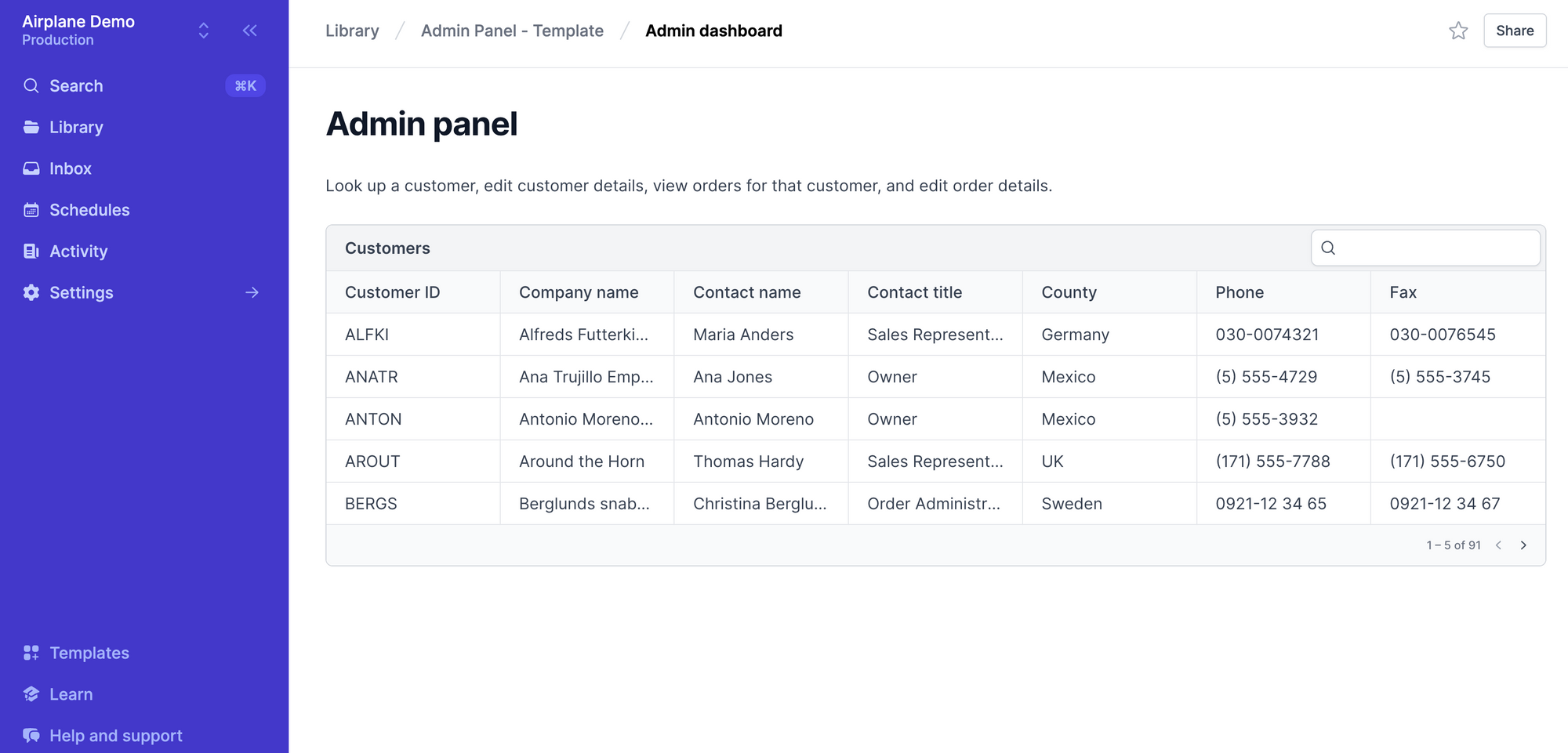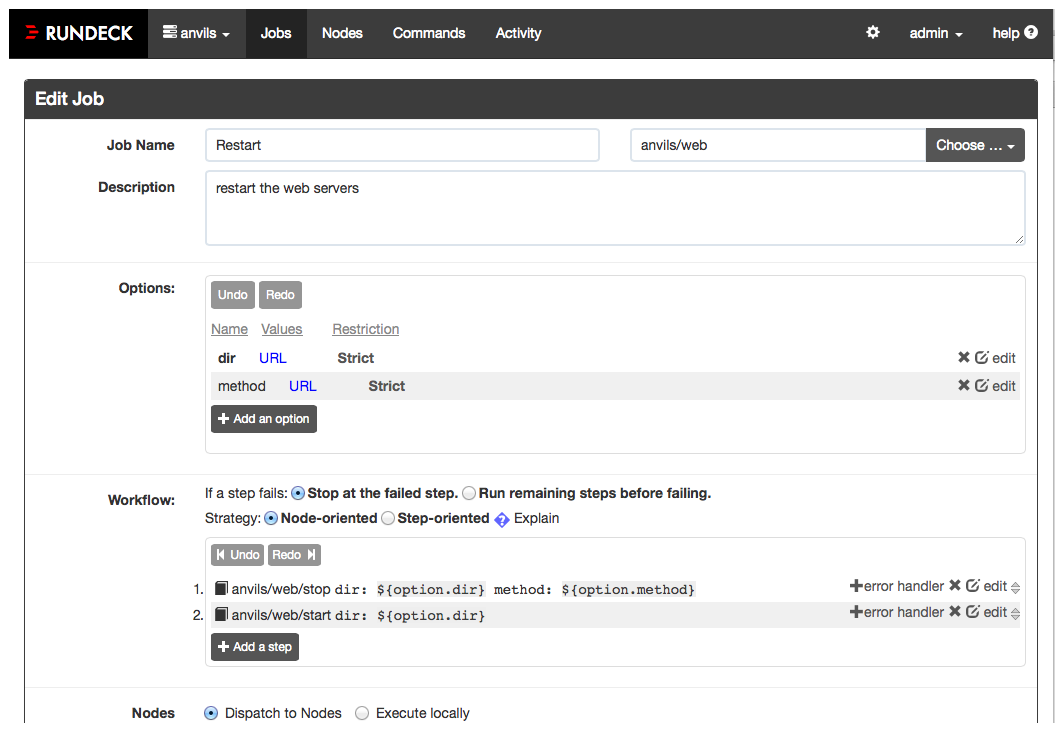Here at Airplane, we get asked often about the differences between Airplane and Rundeck. We thought we'd give our take. We're obviously biased towards our approach, but we started building Airplane in part due to some of the needs we had that existing tools, like Rundeck, didn't meet.
What is Rundeck?
Rundeck is a platform for workflow automation. It's a way of taking sensitive, technical operations that are being executed manually (e.g. "run a script to restart a service") and turning them into self-service apps that can be shared within an organization.
DevOps engineers, infrastructure engineers, and IT administrators use Rundeck to make common operations more self-service for others in their organization. For example, let's say you're an engineer who has written a script to clear a cache, restart a service, or run a data processing job. If you or your team are the only people with the permissions and expertise to run that script safely, you may quickly become a bottleneck for others in the business who need that work done.
Rundeck makes it possible to take this script and turn it into a GUI-based internal tool that you can share with others. Anyone with the right permissions can then trigger the script themselves, even if they don't have the expertise or access to run it on their own.
However, there are aspects to Rundeck that make it hard to use:
- Difficult to install: A subset of Rundeck's functionality is available for free as an open core offering. Free users of Rundeck are on their own to install and configure Rundeck, and the installation process is long and error-prone. Expect to invest a day at minimum, possibly much longer, into setting up Rundeck for even a simple use case.
- Difficult to maintain: Rundeck requires significant effort to scale and maintain over time. It doesn't abstract away any of the infrastructure management related to these operational tasks, which means that people creating automations on Rundeck end up investing tons of time and effort continuing to maintain these runbooks over time. From a G2 crowd review: "Every upgrade is a roller coaster of regressions and new frustrating problems, undocumented mandatory upgrade steps."
- Poor UI support: The Rundeck UI is hard to use, and lacks functionality. Basic things like user permissions aren't configurable from the UI. Several G2 crowd reviews mention how the UI is feature-poor and hard to use. Non-technical end-users especially have a tough time using tasks built in Rundeck.
- Expensive, enterprise-only full version: If you want to use Rundeck's full offering as a hosted, managed solution, it requires speaking to a sales team and spending a lot. According to a review on G2 crowd, Rundeck is "ridiculously expensive in relation to the perceived gain."
Ultimately, for many organizations, Rundeck doesn't live up to its promise of allowing domain experts to make sensitive operations more self-service for their teammates. Due to maintenance and other issues, Rundeck users continue to have to stay in the loop on these operations.
Airplane for workflow automation
At Airplane, we're building a significantly simpler approach to this problem. Airplane offers many of the same features as Rundeck. At its core, Airplane also allows you to transform technical operations like scripts or SQL queries and transform them into GUI-based internal apps that anyone can use.
Airplane is a fully-hosted solution that's optimized for a great UI experience, fast time to value, and low maintenance. In just 5 minutes, you can sign up for Airplane, deploy a script written in Python, JS, SQL, Shell, or any other language, and create a self-serve lightweight app. You can share this app with anyone in the company, even non-technical people on support or operations teams.
Check out our 4-minute demo to see how it works:
Overall, Airplane outperforms Rundeck:
- Fast setup: As shown in the video above, it takes only a couple of minutes to deploy a task to Airplane.
- Rich UI support: Airplane Tasks can be configured entirely through the UI. Task creators can specify input validation rules, granular access controls, access request flows and more through the UI. The UI also provides a searchable, filterable audit log of all activity. End users of tasks created in Airplane find it intuitive and easy to use.
- Native support for Javascript and Python: While you can create Airplane Tasks as SQL queries or REST API calls, tasks also natively support Javascript and Python. Because Airplane is code-first, you can do anything that you would normally do in either Javascript or Python right from within Airplane. And if you have existing one-off scripts, these can easily be ported into Tasks without a ton of refactoring.
- Low maintenance: Once an Airplane Task is live, it takes no marginal effort to maintain. Unlike Rundeck, Airplane uses a Docker-based agent to run tasks. Airplane agents require no configuration or work to get started with and are completely abstracted away from the developer–unless of course you want more control, in which case they're highly configurable and flexible.
- Fairly priced: Airplane is free for small teams and we even offer $10,000 worth of credits to help startups get up and running. It's a hosted solution, even for free users, so you can get started with zero installation or configuration. For mid-sized teams, Airplane has a low per-user fee that makes it easy to ramp up usage without getting a surprise bill.
- Simple approval workflows: One of Airplane's most commonly used features is the ability to grant certain users the ability to run tasks only after they've been approved by another user with a higher level of access. Approval flows allow you to grant access to sensitive operations widely to people in the business.
In addition to being faster and easier to use, though, Airplane also broadens the set of potential developers and use cases. For developers, i.e. people creating tasks within Airplane, it requires technical knowledge, but not nearly as much infrastructure expertise as Rundeck. Therefore any engineer in a business, or even a SQL-savvy analyst, can use Airplane to build tasks.
Tasks and Workflows in Airplane
Tasks are at the core of the Airplane experience. Tasks are SQL queries, REST API calls, Python scripts, Javascript functions, or shell scripts that any user on your team can execute once they're built and power the rest of the Airplane experience. Tasks can be used for anything from single-step operations (start/restart a microservice, hit an API endpoint) to elaborate multi-step functions (customer onboarding workflow, GDPR deletion process).
And once you have created a set of Tasks in Airplane, they can be combined into Workflows with the ability to prompt users and wait for a response before continuing, apply fine-grained permissions, and run for up to 60 days. This enables you to build drip campaigns, deployment pipelines, or processes that require input from multiple stakeholders (e.g. onboarding) right within Airplane.
Using Airplane Views to create friendly UIs
Airplane's UI is also friendlier to non-technical business users, so operational tasks like "toggle a feature flag" or "reset a user's password" can be quickly created in Airplane and shared with support, sales, customer success, product, and other non-technical users.
And with the introduction of Views in Airplane, developers can build full-featured React-based Views and turn them into admin panels, dashboards and more. Airplane comes with a ton of pre-built Components that can be used in Views out-of-the-box, but since Views are based on React, 3rd-party components are supported as well.

If you're curious about how some of our customers are using Views, check out some of the pre-built Templates that you can use to get started with Airplane and have a fully-functioning interface in just a few clicks.
Running your workflows on Airplane
Small teams and large enterprises are migrating away from Rundeck to Airplane. Read our docs to learn more, or sign up today and start using Airplane for free. If you are at a startup that is series A or earlier with under 100 employees, check out our Airplane Startup Program to redeem $10,000 in Airplane credits.



